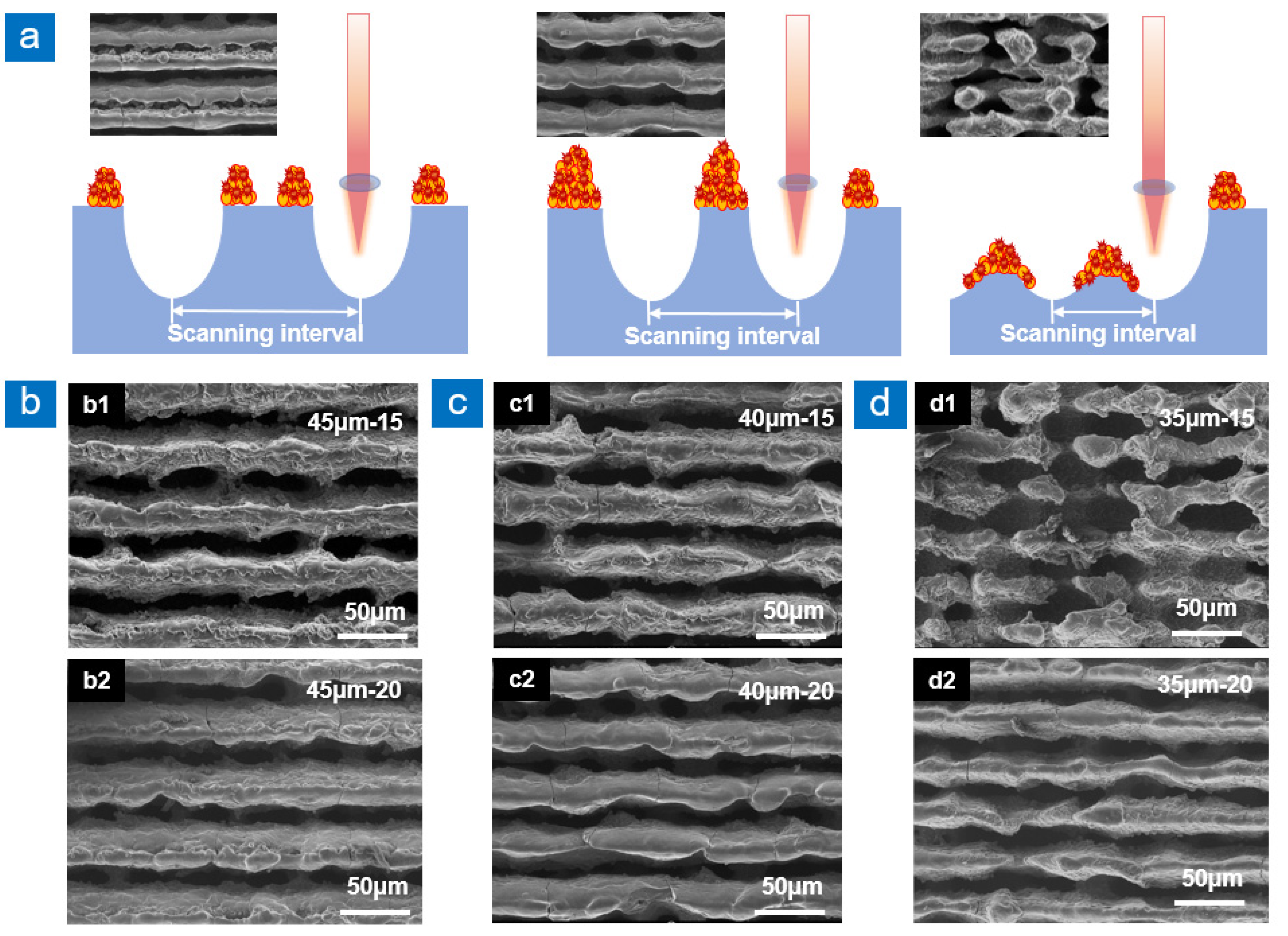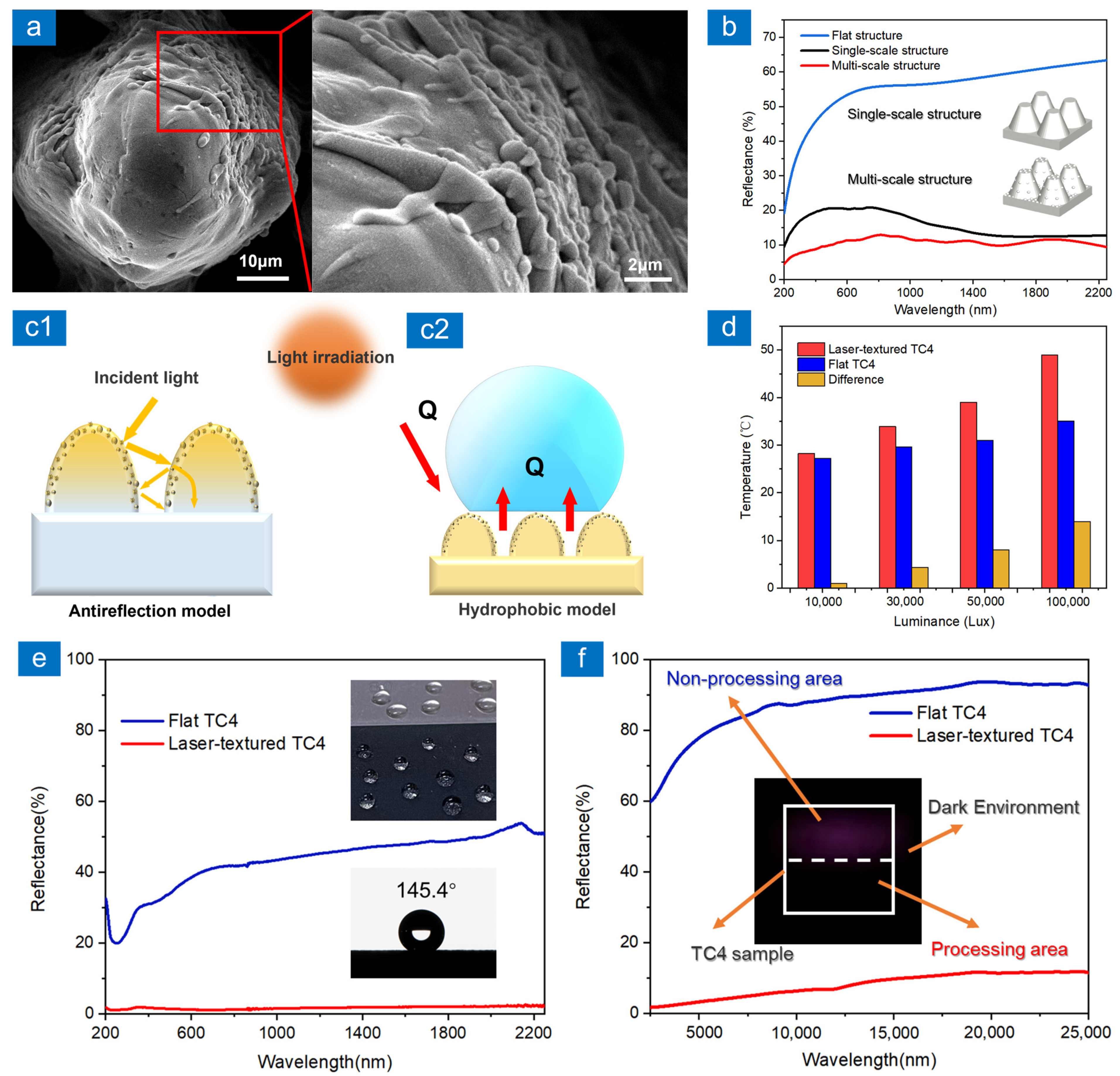Thermal-Assisted Laser Fabrication of Broadband Ultralow Reflectance Surface by Combining Marangoni Flow with In Situ Deposition
Abstract
1. Introduction
2. Experimental
2.1. Materials and Methods
2.2. Characterization and Measurement
3. Results and Discussion
3.1. Marangoni Flow and In Situ Deposition
3.2. Preparation of Multi-Scale Microcolumn Structure
3.3. Thermal-Assisted Strategy
3.4. Model and Application
4. Conclusions
Author Contributions
Funding
Institutional Review Board Statement
Informed Consent Statement
Data Availability Statement
Conflicts of Interest
References
- Xie, Z.T.; Wang, H.; Li, M.; Tian, Y.; Deng, Q.Y.; Chen, R.; Zhu, X.; Liao, Q. Photothermal trap with multi-scale micro-nano hierarchical structure enhances light absorption and promote photothermal anti-icing/deicing. Chem. Eng. J. 2022, 435, 135025. [Google Scholar] [CrossRef]
- Sharshir, S.W.; Rozza, M.A.; Joseph, A.; Kandeal, A.W.; Tareemi, A.A.; Abou-Taleb, F.; Kabeel, A.E. A new trapezoidal pyramid solar still design with multi thermal enhancers. Appl. Therm. Eng. 2022, 213, 118699. [Google Scholar] [CrossRef]
- Sheikholeslami, M.; Jafaryar, M.; Gerdroodbary, M.B.; Alavi, A.H. Influence of novel turbulator on efficiency of solar collector system. Environ. Technol. Innov. 2022, 26. [Google Scholar] [CrossRef]
- Hosenuzzaman, M.; Rahim, N.A.; Selvaraj, J.; Hasanuzzaman, M.; Malek, A.; Nahar, A. Global prospects, progress, policies, and environmental impact of solar photovoltaic power generation. Renew. Sustain. Energy Rev. 2015, 41, 284–297. [Google Scholar] [CrossRef]
- Wang, Y.; Liu, P.; Vogelbacher, F.; Li, M. Bioinspired multiscale optical structures towards efficient light management in optoelectronic devices. Mater. Today Nano 2022, 19, 100225. [Google Scholar] [CrossRef]
- Guo, C.F.; Sun, T.Y.; Cao, F.; Liu, Q.; Ren, Z.F. Metallic nanostructures for light trapping in energy-harvesting devices. Light-Sci. Appl. 2014, 3, e161. [Google Scholar] [CrossRef]
- Hajian, H.; Rukhlenko, I.D.; Hanson, G.W.; Ozbay, E. Anisotropic absorber and tunable source of MIR radiation based on a black phosphorus-SiC metasurface. Photonics Nanostructures-Fundam. Appl. 2022, 50, 101020. [Google Scholar] [CrossRef]
- Kim, D.G.; Choi, J.H.; Choi, D.K.; Kim, S.W. Highly Bendable and Durable Transparent Electromagnetic Interference Shielding Film Prepared by Wet Sintering of Silver Nanowires. Acs Appl. Mater. Interfaces 2018, 10, 29730–29740. [Google Scholar] [CrossRef]
- Qin, Y.S.; Zhang, M.J.; Guan, Y.; Huang, X.G. Laser absorption and infrared stealth properties of Al/ATO composites. Ceram. Int. 2019, 45, 14312–14315. [Google Scholar] [CrossRef]
- Kim, J.; Han, K.; Hahn, J.W. Selective dual-band metamaterial perfect absorber for infrared stealth technology. Sci. Rep. 2017, 7, 6740. [Google Scholar] [CrossRef]
- Wang, H.R.; Zhang, F.; Wang, C.; Duan, J.A. Broadband antireflective subwavelength structures for infrared detection. Opt. Laser Technol. 2022, 149, 107931. [Google Scholar] [CrossRef]
- Zhang, Y.; Gao, Y.D.; Yu, D.S.; Zhou, J.P.; Sun, D.Q. Preparation of high-strength TC4/304 dissimilar joint with TA2/304 composite interlayer by a dual-pass laser. Opt. Laser Technol. 2022, 154, 108298. [Google Scholar] [CrossRef]
- Venkatesh, S.; Joy, N.; Mageshwaran, G.; Durairaj, R.B.; Reddy, B.S.; Reddy, G.P. Investigation on the electrochemical characteristics of Ti-6Al-4 V weldment. In Proceedings of the 3rd International Conference on Frontiers in Automobile and Mechanical Engineering (FAME), Chennai, India, 2–4 April 2020; pp. 3727–3731. [Google Scholar]
- Raut, H.K.; Ganesh, V.A.; Nair, A.S.; Ramakrishna, S. Anti-reflective coatings: A critical, in-depth review. Energy Environ. Sci. 2011, 4, 3779–3804. [Google Scholar] [CrossRef]
- Han, Z.W.; Jiao, Z.B.; Niu, S.C.; Ren, L.Q. Ascendant bioinspired antireflective materials: Opportunities and challenges coexist. Prog. Mater. Sci. 2019, 103, 1–68. [Google Scholar] [CrossRef]
- Xiong, J.; Das, S.N.; Shin, B.; Kar, J.P.; Choi, J.H.; Myoung, J.M. Biomimetic hierarchical ZnO structure with superhydrophobic and antireflective properties. J. Colloid Interface Sci. 2010, 350, 344–347. [Google Scholar] [CrossRef]
- Xin, G.Q.; Wu, C.Y.; Cao, H.Y.; Liu, W.N.; Li, B.; Huang, Y.; Rong, Y.M.; Zhang, G.J. Superhydrophobic TC4 alloy surface fabricated by laser micro-scanning to reduce adhesion and drag resistance. Surf. Coat. Technol. 2020, 391, 125707. [Google Scholar] [CrossRef]
- Wang, H.P.; Guan, Y.C.; Zheng, H.Y.; Hong, M.H. Controllable fabrication of metallic micro/nano hybrid structuring surface for antireflection by picosecond laser direct writing. Appl. Surf. Sci. 2019, 471, 347–354. [Google Scholar] [CrossRef]
- Su, Y.; Wang, S.Q.; Yao, D.W.; Fu, Y.; Zang, H.W.; Xu, H.L.; Polynkin, P. Stand-off fabrication of irregularly shaped, multi-functional hydrophobic and antireflective metal surfaces using femtosecond laser filaments in air. Appl. Surf. Sci. 2019, 494, 1007–1012. [Google Scholar] [CrossRef]
- Yan, T.Y.; Ji, L.F.; Hong, M.H. Backside wet etching of sapphire substrate by laser-induced carbothermal reduction. Opt. Laser Technol. 2022, 149, 107900. [Google Scholar] [CrossRef]
- Li, X.; Li, M.; Liu, H.J. Effective strategy to achieve a metal surface with ultralow reflectivity by femtosecond laser fabrication. Chin. Opt. Lett. 2021, 19, 051401. [Google Scholar] [CrossRef]
- Li, J.R.; Xu, J.K.; Lian, Z.X.; Yu, Z.J.; Yu, H.D. Fabrication of antireflection surfaces with superhydrophobic property for titanium alloy by nanosecond laser irradiation. Opt. Laser Technol. 2020, 126, 106129. [Google Scholar] [CrossRef]
- Fan, P.X.; Bai, B.F.; Zhong, M.L.; Zhang, H.J.; Long, J.Y.; Han, J.P.; Wang, W.Q.; Jin, G.F. General Strategy toward Dual-Scale-Controlled Metallic Micro-Nano Hybrid Structures with Ultralow Reflectance. Acs Nano 2017, 11, 7401–7408. [Google Scholar] [CrossRef]
- Du, M.D.; Sun, Q.Q.; Jiao, W.; Shen, L.F.; Chen, X.; Xiao, J.F.; Xu, J.F. Fabrication of Antireflection Micro/Nanostructures on the Surface of Aluminum Alloy by Femtosecond Laser. Micromachines 2021, 12, 1406. [Google Scholar] [CrossRef] [PubMed]
- Lou, R.; Zhang, G.D.; Li, G.Y.; Li, X.L.; Liu, Q.; Cheng, G.H. Design and Fabrication of Dual-Scale Broadband Antireflective Structures on Metal Surfaces by Using Nanosecond and Femtosecond Lasers. Micromachines 2020, 11, 20. [Google Scholar] [CrossRef] [PubMed]
- Cui, J.; Xia, H.Y.; Su, C.W.; Yang, G.F. Research on ice suppression performance of titanium alloy surface induced by nanosecond laser. J. Mater. Res. Technol.-JmrT 2022, 19, 1578–1589. [Google Scholar] [CrossRef]
- Yong, J.L.; Chen, F.; Yang, Q.; Zhang, D.S.; Farooq, U.; Du, G.Q.; Hou, X. Bioinspired underwater superoleophobic surface with ultralow oil-adhesion achieved by femtosecond laser microfabrication. J. Mater. Chem. A 2014, 2, 8790–8795. [Google Scholar] [CrossRef]
- Chen, Z.K.; Zhou, R.; Yan, H.P.; Lin, Y.H.; Huang, W.P.; Yuan, G.F.; Cui, J.Q. Bioinspired robust top-perforated micro-conical array of TC4 surface fabricated by pulsed laser ablation for enhanced anti-icing property. J. Mater. Sci. 2022, 57, 8890–8903. [Google Scholar] [CrossRef]
- Guo, C.F.; Zhang, M.J.; Hu, J. Fabrication of hierarchical structures on titanium alloy surfaces by nanosecond laser for wettability modification. Opt. Laser Technol. 2022, 148, 107728. [Google Scholar] [CrossRef]
- Yin, J.B.; Yan, H.P.; Dunzhu, G.; Wang, R.; Cao, S.Z.; Zhou, R.; Li, Y.Z. General Strategy toward Laser Single-Step Generation of Multiscale Anti-Reflection Structures by Marangoni Effect. Micromachines 2022, 13, 1491. [Google Scholar] [CrossRef]
- Zhang, D.S.; Sugioka, K. Hierarchical microstructures with high spatial frequency laser induced periodic surface structures possessing different orientations created by femtosecond laser ablation of silicon in liquids. Opto-Electron. Adv. 2019, 2, 190002. [Google Scholar] [CrossRef]
- Yang, H.; Gun, X.Y.; Pang, G.H.; Zheng, Z.X.; Li, C.B.; Yang, C.; Wang, M.; Xu, K.C. Femtosecond laser patterned superhydrophobic/hydrophobic SERS sensors for rapid positioning ultratrace detection. Optics Express 2021, 29, 16904–16913. [Google Scholar] [CrossRef] [PubMed]
- Yang, H.; Xu, K.C.; Xu, C.W.; Fan, D.Y.; Cao, Y.; Xue, W.; Pang, J.H. Femtosecond Laser Fabricated Elastomeric Superhydrophobic Surface with Stretching-Enhanced Water Repellency. Nanoscale Res. Lett. 2019, 14, 333. [Google Scholar] [CrossRef] [PubMed]
- Liu, X.Q.; Bai, B.F.; Chen, Q.D.; Sun, H.B. Etching-assisted femtosecond laser modification of hard materials. Opto-Electron. Adv. 2019, 2, 190021. [Google Scholar] [CrossRef]
- Yang, J.; Luo, F.F.; Kao, T.S.; Li, X.; Ho, G.W.; Teng, J.H.; Luo, X.G.; Hong, M.H. Design and fabrication of broadband ultralow reflectivity black Si surfaces by laser micro/nanoprocessing. Light-Sci. Appl. 2014, 3, e185. [Google Scholar] [CrossRef]
- Yuan, J.D.; Liang, L.; Lin, G.Z. Study on processing characteristics and mechanisms of thermally assisted laser materials processing. Surf. Coat. Technol. 2019, 378, 124946. [Google Scholar] [CrossRef]
- Fan, P.X.; Bai, B.F.; Long, J.Y.; Jiang, D.F.; Jin, G.F.; Zhang, H.J.; Zhong, M.L. Broadband High-Performance Infrared Antireflection Nanowires Facilely Grown on Ultrafast Laser Structured Cu Surface. Nano Lett. 2015, 15, 5988–5994. [Google Scholar] [CrossRef]






| Sample | Ti (%) | O (%) |
|---|---|---|
| Stru-120 (26 °C) | 38.23 | 61.77 |
| Stru-120 (150 °C) | 32.14 | 67.86 |
Disclaimer/Publisher’s Note: The statements, opinions and data contained in all publications are solely those of the individual author(s) and contributor(s) and not of MDPI and/or the editor(s). MDPI and/or the editor(s) disclaim responsibility for any injury to people or property resulting from any ideas, methods, instructions or products referred to in the content. |
© 2023 by the authors. Licensee MDPI, Basel, Switzerland. This article is an open access article distributed under the terms and conditions of the Creative Commons Attribution (CC BY) license (https://creativecommons.org/licenses/by/4.0/).
Share and Cite
Yin, J.; Yan, H.; Zhou, R.; Li, Y.; He, A. Thermal-Assisted Laser Fabrication of Broadband Ultralow Reflectance Surface by Combining Marangoni Flow with In Situ Deposition. Nanomaterials 2023, 13, 480. https://doi.org/10.3390/nano13030480
Yin J, Yan H, Zhou R, Li Y, He A. Thermal-Assisted Laser Fabrication of Broadband Ultralow Reflectance Surface by Combining Marangoni Flow with In Situ Deposition. Nanomaterials. 2023; 13(3):480. https://doi.org/10.3390/nano13030480
Chicago/Turabian StyleYin, Jingbo, Huangping Yan, Rui Zhou, Yuanzhe Li, and Anna He. 2023. "Thermal-Assisted Laser Fabrication of Broadband Ultralow Reflectance Surface by Combining Marangoni Flow with In Situ Deposition" Nanomaterials 13, no. 3: 480. https://doi.org/10.3390/nano13030480
APA StyleYin, J., Yan, H., Zhou, R., Li, Y., & He, A. (2023). Thermal-Assisted Laser Fabrication of Broadband Ultralow Reflectance Surface by Combining Marangoni Flow with In Situ Deposition. Nanomaterials, 13(3), 480. https://doi.org/10.3390/nano13030480







